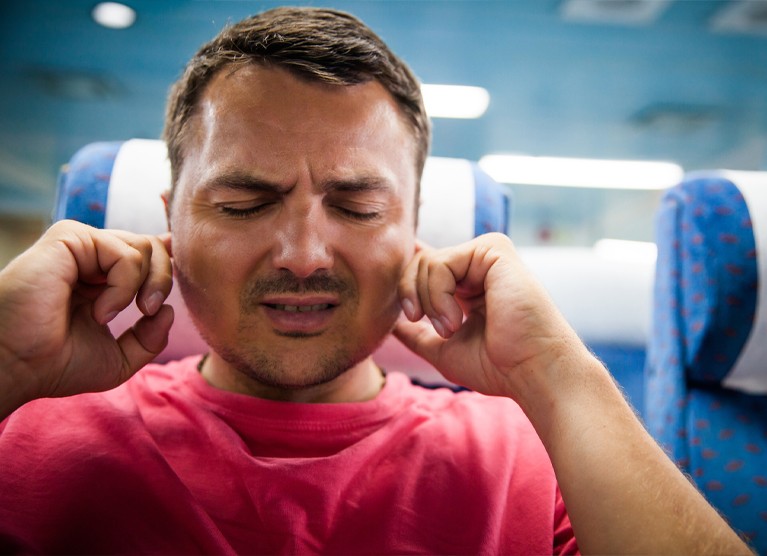Ear Pain on Airplanes: What Is It & What Can You Do?
Are you a frequent flyer or someone planning your next vacation? If so, you may have felt pressure or pain in your ears during takeoff or landing.
Maybe you’ve even asked, “Why do my ears hurt on planes?” You're not alone—this is one of the most common travel-related health complaints.
What Causes Ear Pain During Airplane Takeoff and Landing?
The primary cause of ear pain during air travel is rapid changes in air pressure. As the plane climbs or descends, the pressure around you shifts faster than your body can adjust. This creates a pressure imbalance between your middle ear and the cabin air.
This imbalance causes your eardrum (tympanic membrane) to stretch inward or outward, leading to:
- A feeling of fullness or clogging
- Popping or crackling
- Sharp pain in one or both ears
- Temporary hearing changes
The key to preventing discomfort is helping your Eustachian tubes—tiny passageways that connect your middle ear to your throat—equalize the pressure.

How Do I Stop My Ears from Hurting When Flying?
To avoid ear pain during flights, especially during takeoff and landing, try the following:
- Swallow frequently: Swallowing activates the muscles that open your Eustachian tubes. Sucking on candy or chewing gum encourages this naturally.
- Perform the Valsalva maneuver: Gently pinch your nose, close your mouth, and blow softly. This forces air through the Eustachian tubes to equalize pressure.
- Try the Toynbee maneuver: Close your mouth and nose and swallow repeatedly. It’s a gentler method and helpful if you’re congested.
- Use filtered earplugs for flying: These earplugs regulate air pressure changes gradually and reduce the shock to your ears.
You can also read more about muffled hearing in one ear here.
What’s the Best Remedy for Airplane Ear Pressure?
If you're prone to ear pain on flights, plan ahead with these additional remedies:
- Use nasal sprays: A spray like Flonase can reduce swelling in your nasal passages and help open Eustachian tubes. Use it 1–2 hours before flying.
- Take a decongestant: Medications like Sudafed (pseudoephedrine) can reduce pressure and inflammation. Take one dose about an hour before takeoff or landing. (Check with your doctor before use.)
- Stay hydrated: Drinking water helps thin mucus and keeps nasal passages moist.
- Avoid sleeping during descent: This is when pressure changes are most significant. Stay awake to actively manage your symptoms.
Overusing decongestants or sprays may lead to rebound congestion. Always follow product guidelines and consult your doctor if unsure.

Preventing Ear Pain When Flying
If you’re planning to fly and want to minimize ear issues, consider these preventive steps:
- Use a nasal spray like Flonase the day before and day of travel
- Take Sudafed or another decongestant 60–90 minutes before your flight (if medically appropriate)
- Invest in travel earplugs specifically designed to reduce barometric pressure impact
- Stay upright and hydrated—avoid alcohol and caffeine which may dry out airways
- Reschedule your flight if you're severely congested or recovering from illness
When to See a Doctor After Flying
Most airplane-related ear pain resolves within a few hours after landing. But if you experience any of the following, contact a hearing care provider:
- Persistent ear pain lasting more than 24–48 hours
- Hearing loss that doesn't improve
- Fluid drainage or blood from the ear
- Dizziness, nausea, or balance problems
These symptoms could signal a barotrauma-related injury or underlying infection.
Final Thoughts
Ear pain during air travel is common but preventable. By understanding how air pressure affects your ears—and taking steps like decongestants, nasal sprays, or pressure-regulating earplugs—you can enjoy your flight without the discomfort.
If you’re still experiencing pain or hearing issues after your flight, schedule an appointment with a hearing care professional. They can determine whether your symptoms are temporary or require further treatment.

Take Online Hearing Test
Take our free at-home hearing loss test as a first step on your journey to better hearing.

Book Your Free Appointment

Reviewed By
Kathy McGowan, AuD CCC-A, Doctor of Audiology
Kathy McGowan is the Manager of Managed Care Programs with Beltone Corporation . Kathy worked with the Professional Development Training Team as well as the Operations Team and Beltone Corporate Retail for 8 years before being promoted to her current position. Prior to joining Beltone Corporate, Kathy worked for 10 years as an Audiology Manager in a private practice. She has worked in many settings as an Audiologist including an ENT practice, a hospital, an Optical and Hearing Company, and in the Military, retiring as a LtCol. Kathy earned her Bachelor’s in Speech and Hearing and Master’s in Audiology from Ohio University in Athens, Ohio, and went on to receive her Audiology Doctorate from A.T. Still University School of Health Sciences. Kathy is currently licensed in seven states.

